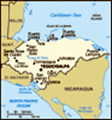Advertisement
The countryside around Gracias is beautiful. The air is mild and clear, the occasional bus or car shares the road with an infrequent two wheeled cart pulled by draft animals, and they all bump along the road that climbs higher and higher as it travels to small towns sprinkled among the verdant hills. The rains have started, things are greening up. Farmers are turning their fields, some with teams of oxen pulling plows. Horses, some of them saddled and ready to go, stand outside some of the houses. Terraced hillsides rise, layered with banana trees, coffee, and a kind of sugar cane used as feed for cattle. Small houses of earth, metal, terracotta tile or corrugated metal roofs, brick, wood, most with white washed walls, some with satelite TV dishes, all with at least a small plot of carefully tended flowers, blend into the land as naturally as the stones and trees that grow everywhere.
My guide, Mike, drives me to these places, and I revel in the sights and the feeling of bigness. The tall hills of Celaque National park, mist hugging the tops, form the backdrop for these grand vistas. I'm excited by the beauty, the freshness. We
stop in La Campa, a small town that is so sleepy but simply there, and admire the church from the outside. We visit Donia Desiderea, a grandmother who makes huge ollas.. She pats large mounds of clay, adds sand, rolls a huge cylinder, sticks her fist in the middle to begin hollowing the interior for the next olla. She shapes and flattens the walls of the clay blob, builds the sides higher with giant coils of clay. She bends over to do this, because the future olla is now sitting on the floor, and there is where its final form must emerge. I imagine that her back is sore. The young women do not want to learn this art because of all the work. Her three year old grandson patiently mimics his grandmother's movements, and makes a small pot of his own. She says he keeps her company.
Along the road to Cruz Alto, we stop and buy a small basket made of pine needles from a woman walking along the road. We pick up a young mother and fat baby and she sits in the back seat of the truck. She was starting the hour long walk to
Cruz Alto. Her husband was on a horse carrying the baby. Mike asks her all kinds of questions, she shyly answers with a short "yes" to all of them. My the four month old baby is fat! He gives me a fleeting smile before he falls asleep in his mother's swaying arms.
We reach Cruz Alto, where it seems the top of the world. We stop at a small bakery, where five women are patiently forming small bread buns dipped in sugar. The fire is started in the horno outside, they will bake them soon. Their small business supplies buns to the population in the region, about 850 people.
I take photos of the women working, and of the man who is minding the store in the front. This is a Lenca village, indigenous people who seem to be living from day to day. He smiles, and dots of silver are embedded in his teeth. He has a lovely smile. I tell him I will send him copies of the photos. Mike chats with him in Spanish--mine is still so limited that I miss a lot of the banter. All I know is that this man and the
women working nearby are gentle and quiet. Everywhere we go, people do not hesitate to wave and smile at the odd tourista snapping photos of their animals, hornos, and bananas.
The road to the next village is very poor, not suitable for our two wheel drive, so we have to bypass it this trip. That´s ok for now, because I know that the promise of future adventure will bring me back. There are so many hidden villages that one must reach by foot only, and I get a tingle of excitement about perhaps ¨discovering¨them on future travels.
We stop at a small comedor along the road for lunch. There are two small cages with parrots in them, a sleepy white dog, two wooden tables and several plastic chairs under a shaded area. Nothing else but a sign would suggest that we could eat lunch there. But our plates are overflowing with food that soon emerge from the small simple house. I demolish my whole fried fish--tilapia, fresh from the coast, and Mike eats his grilled chicken. I challenge Mike to eat some of the pickled peppers in the large jar on the table. He declines. I watch the
little chicken hop on the sleeping dog and peck at the fleas or some small creatures in his coat. A man on a horse rides by, a couple of public buses bounce by, but otherwise, it is quiet. And no one knows we are there. And it really doesn´t matter.
This is one of the most beautiful places I have seen in Honduras. Even Mike, who guides tour buses and has shown many people around his country, remarks that he has forgotten about this region, and thinks he should bring his wife here for a second honeymoon. It is so quiet and slow. We don´t hear radios blaring out of every house, we don´t hear or see televisions mesmerizing the viewers. Instead, on this quiet Saturday, we see people outside, gathering firewood, plowing fields, hanging laundry, tending flowers, going about their daily business. I think they know what they have there in the hills outside of Gracias, Honduras.
Advertisement
Tot: 0.189s; Tpl: 0.013s; cc: 12; qc: 72; dbt: 0.1311s; 1; m:domysql w:travelblog (10.17.0.13); sld: 1;
; mem: 1.2mb























